LAW1110 - Legal Institutional Methods: Essay on Disclosure
VerifiedAdded on 2022/08/09
|9
|2299
|27
Essay
AI Summary
This essay delves into the detrimental effects of outdated rules concerning the disclosure of unused material in criminal trials. It examines how these outdated regulations undermine the fairness and effectiveness of the legal process, potentially leading to wrongful convictions and a compromised justice system. The study explores the relevant legislation, including the Criminal Procedure and Investigations Act 1996 (CPIA), and highlights the concerns raised by policymakers and practitioners regarding the non-disclosure of evidence. The analysis covers the historical context of disclosure procedures, the roles of various stakeholders, and the implications of legislative loopholes. It also reviews the importance of ensuring a free and fair trial and the need for stronger laws to address the misuse of disclosure provisions. The essay concludes by emphasizing the importance of amending the legislation to ensure that the criminal justice system functions effectively and delivers justice.
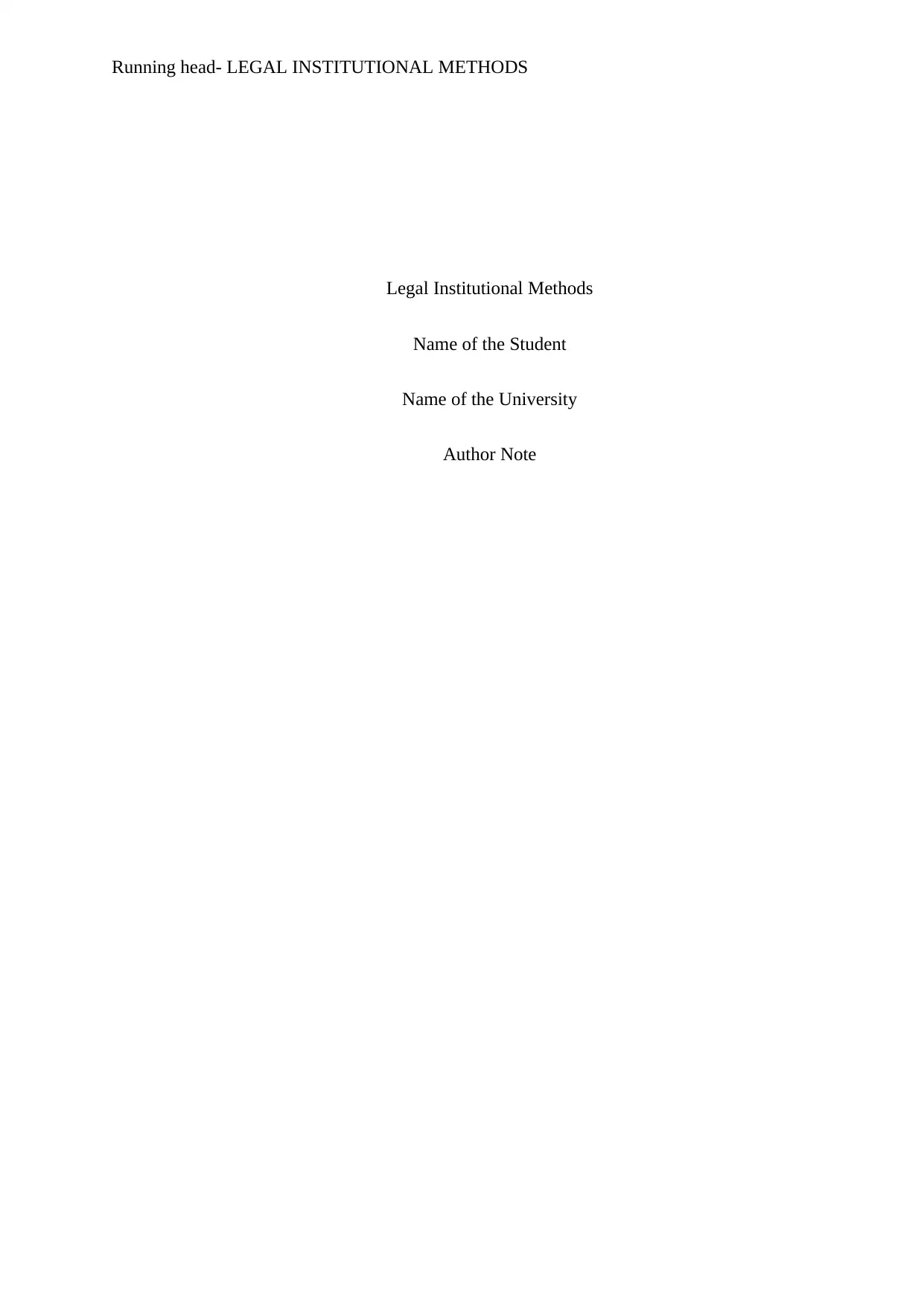
Running head- LEGAL INSTITUTIONAL METHODS
Legal Institutional Methods
Name of the Student
Name of the University
Author Note
Legal Institutional Methods
Name of the Student
Name of the University
Author Note
Paraphrase This Document
Need a fresh take? Get an instant paraphrase of this document with our AI Paraphraser
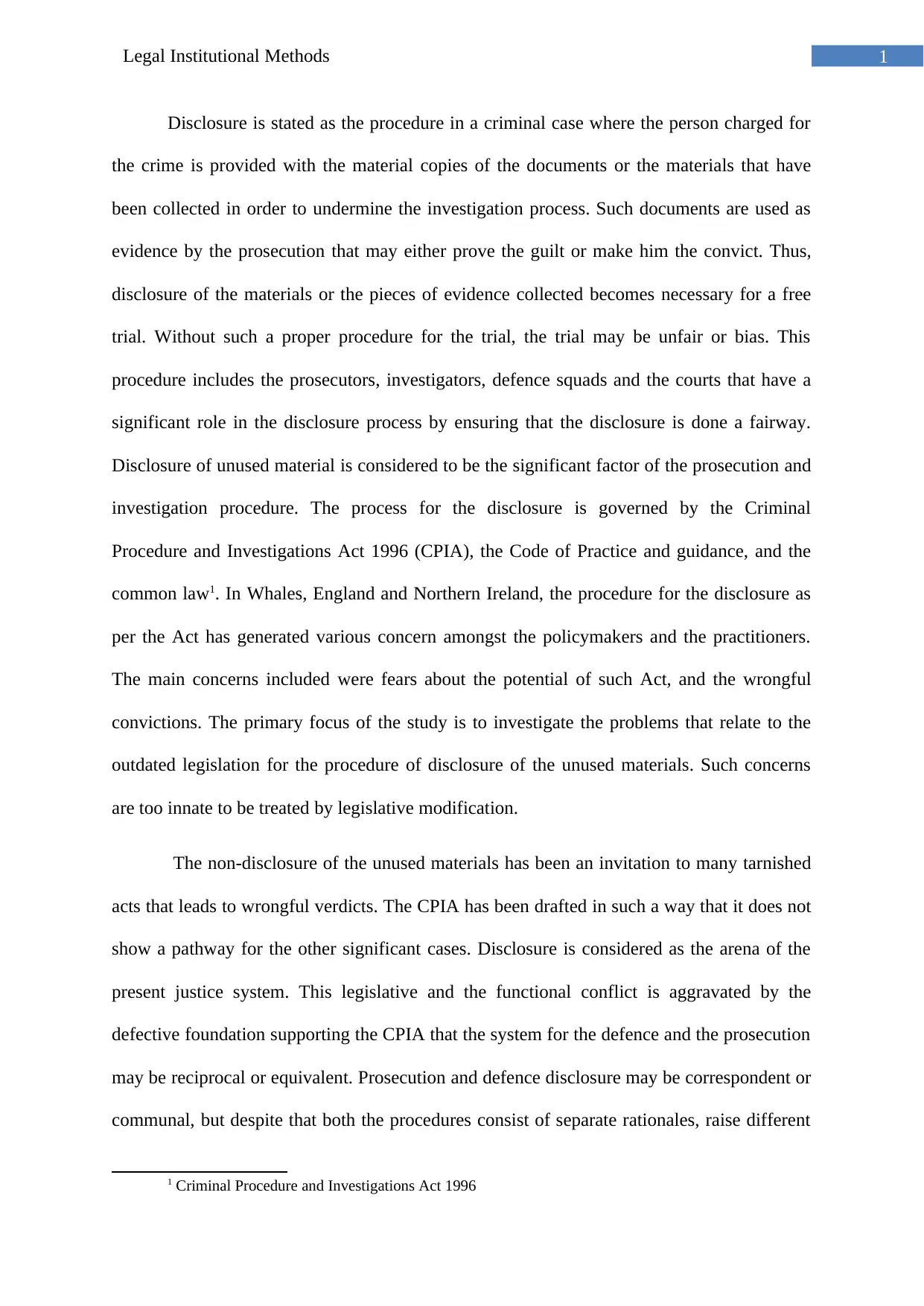
1Legal Institutional Methods
Disclosure is stated as the procedure in a criminal case where the person charged for
the crime is provided with the material copies of the documents or the materials that have
been collected in order to undermine the investigation process. Such documents are used as
evidence by the prosecution that may either prove the guilt or make him the convict. Thus,
disclosure of the materials or the pieces of evidence collected becomes necessary for a free
trial. Without such a proper procedure for the trial, the trial may be unfair or bias. This
procedure includes the prosecutors, investigators, defence squads and the courts that have a
significant role in the disclosure process by ensuring that the disclosure is done a fairway.
Disclosure of unused material is considered to be the significant factor of the prosecution and
investigation procedure. The process for the disclosure is governed by the Criminal
Procedure and Investigations Act 1996 (CPIA), the Code of Practice and guidance, and the
common law1. In Whales, England and Northern Ireland, the procedure for the disclosure as
per the Act has generated various concern amongst the policymakers and the practitioners.
The main concerns included were fears about the potential of such Act, and the wrongful
convictions. The primary focus of the study is to investigate the problems that relate to the
outdated legislation for the procedure of disclosure of the unused materials. Such concerns
are too innate to be treated by legislative modification.
The non-disclosure of the unused materials has been an invitation to many tarnished
acts that leads to wrongful verdicts. The CPIA has been drafted in such a way that it does not
show a pathway for the other significant cases. Disclosure is considered as the arena of the
present justice system. This legislative and the functional conflict is aggravated by the
defective foundation supporting the CPIA that the system for the defence and the prosecution
may be reciprocal or equivalent. Prosecution and defence disclosure may be correspondent or
communal, but despite that both the procedures consist of separate rationales, raise different
1 Criminal Procedure and Investigations Act 1996
Disclosure is stated as the procedure in a criminal case where the person charged for
the crime is provided with the material copies of the documents or the materials that have
been collected in order to undermine the investigation process. Such documents are used as
evidence by the prosecution that may either prove the guilt or make him the convict. Thus,
disclosure of the materials or the pieces of evidence collected becomes necessary for a free
trial. Without such a proper procedure for the trial, the trial may be unfair or bias. This
procedure includes the prosecutors, investigators, defence squads and the courts that have a
significant role in the disclosure process by ensuring that the disclosure is done a fairway.
Disclosure of unused material is considered to be the significant factor of the prosecution and
investigation procedure. The process for the disclosure is governed by the Criminal
Procedure and Investigations Act 1996 (CPIA), the Code of Practice and guidance, and the
common law1. In Whales, England and Northern Ireland, the procedure for the disclosure as
per the Act has generated various concern amongst the policymakers and the practitioners.
The main concerns included were fears about the potential of such Act, and the wrongful
convictions. The primary focus of the study is to investigate the problems that relate to the
outdated legislation for the procedure of disclosure of the unused materials. Such concerns
are too innate to be treated by legislative modification.
The non-disclosure of the unused materials has been an invitation to many tarnished
acts that leads to wrongful verdicts. The CPIA has been drafted in such a way that it does not
show a pathway for the other significant cases. Disclosure is considered as the arena of the
present justice system. This legislative and the functional conflict is aggravated by the
defective foundation supporting the CPIA that the system for the defence and the prosecution
may be reciprocal or equivalent. Prosecution and defence disclosure may be correspondent or
communal, but despite that both the procedures consist of separate rationales, raise different
1 Criminal Procedure and Investigations Act 1996
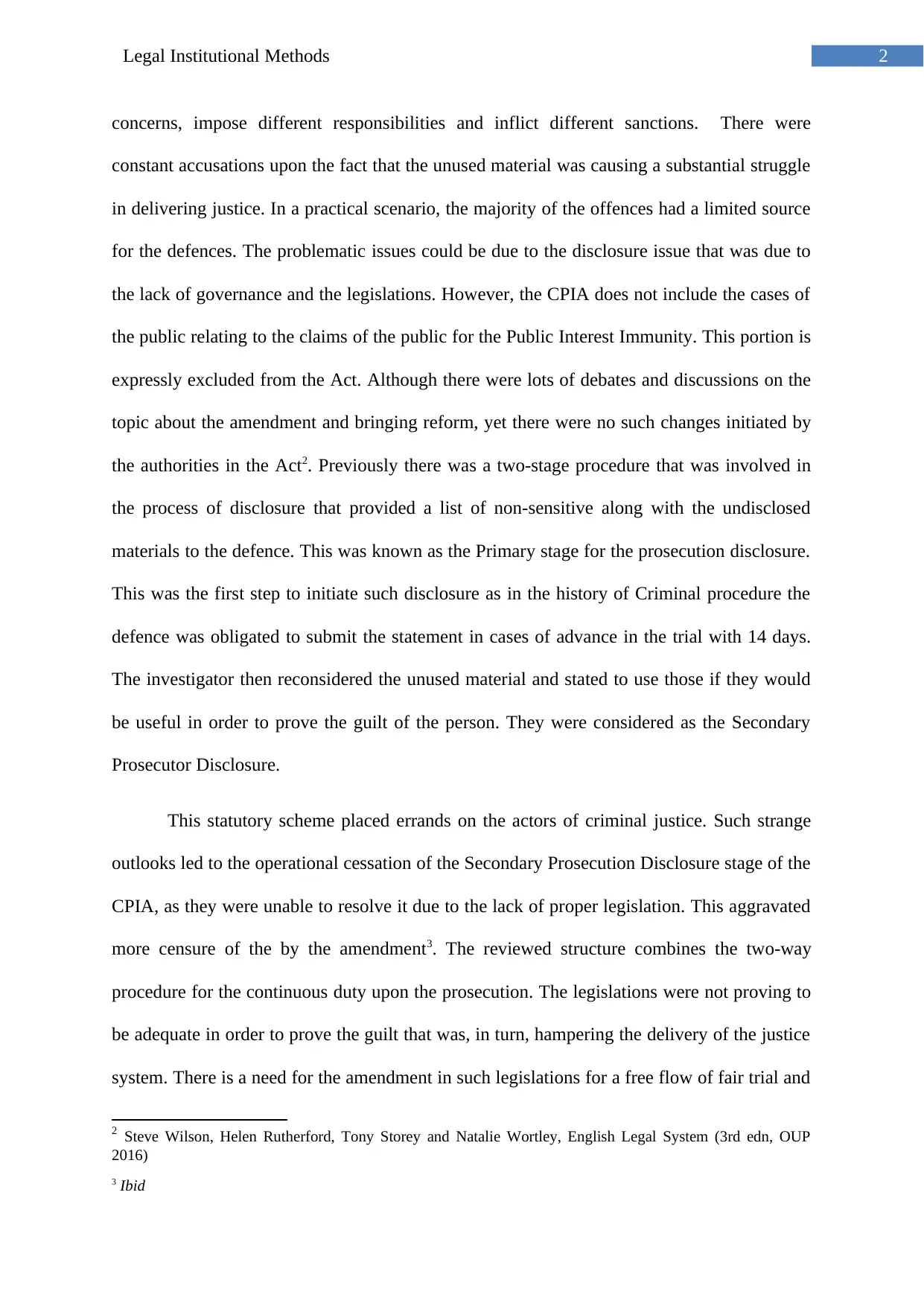
2Legal Institutional Methods
concerns, impose different responsibilities and inflict different sanctions. There were
constant accusations upon the fact that the unused material was causing a substantial struggle
in delivering justice. In a practical scenario, the majority of the offences had a limited source
for the defences. The problematic issues could be due to the disclosure issue that was due to
the lack of governance and the legislations. However, the CPIA does not include the cases of
the public relating to the claims of the public for the Public Interest Immunity. This portion is
expressly excluded from the Act. Although there were lots of debates and discussions on the
topic about the amendment and bringing reform, yet there were no such changes initiated by
the authorities in the Act2. Previously there was a two-stage procedure that was involved in
the process of disclosure that provided a list of non-sensitive along with the undisclosed
materials to the defence. This was known as the Primary stage for the prosecution disclosure.
This was the first step to initiate such disclosure as in the history of Criminal procedure the
defence was obligated to submit the statement in cases of advance in the trial with 14 days.
The investigator then reconsidered the unused material and stated to use those if they would
be useful in order to prove the guilt of the person. They were considered as the Secondary
Prosecutor Disclosure.
This statutory scheme placed errands on the actors of criminal justice. Such strange
outlooks led to the operational cessation of the Secondary Prosecution Disclosure stage of the
CPIA, as they were unable to resolve it due to the lack of proper legislation. This aggravated
more censure of the by the amendment3. The reviewed structure combines the two-way
procedure for the continuous duty upon the prosecution. The legislations were not proving to
be adequate in order to prove the guilt that was, in turn, hampering the delivery of the justice
system. There is a need for the amendment in such legislations for a free flow of fair trial and
2 Steve Wilson, Helen Rutherford, Tony Storey and Natalie Wortley, English Legal System (3rd edn, OUP
2016)
3 Ibid
concerns, impose different responsibilities and inflict different sanctions. There were
constant accusations upon the fact that the unused material was causing a substantial struggle
in delivering justice. In a practical scenario, the majority of the offences had a limited source
for the defences. The problematic issues could be due to the disclosure issue that was due to
the lack of governance and the legislations. However, the CPIA does not include the cases of
the public relating to the claims of the public for the Public Interest Immunity. This portion is
expressly excluded from the Act. Although there were lots of debates and discussions on the
topic about the amendment and bringing reform, yet there were no such changes initiated by
the authorities in the Act2. Previously there was a two-stage procedure that was involved in
the process of disclosure that provided a list of non-sensitive along with the undisclosed
materials to the defence. This was known as the Primary stage for the prosecution disclosure.
This was the first step to initiate such disclosure as in the history of Criminal procedure the
defence was obligated to submit the statement in cases of advance in the trial with 14 days.
The investigator then reconsidered the unused material and stated to use those if they would
be useful in order to prove the guilt of the person. They were considered as the Secondary
Prosecutor Disclosure.
This statutory scheme placed errands on the actors of criminal justice. Such strange
outlooks led to the operational cessation of the Secondary Prosecution Disclosure stage of the
CPIA, as they were unable to resolve it due to the lack of proper legislation. This aggravated
more censure of the by the amendment3. The reviewed structure combines the two-way
procedure for the continuous duty upon the prosecution. The legislations were not proving to
be adequate in order to prove the guilt that was, in turn, hampering the delivery of the justice
system. There is a need for the amendment in such legislations for a free flow of fair trial and
2 Steve Wilson, Helen Rutherford, Tony Storey and Natalie Wortley, English Legal System (3rd edn, OUP
2016)
3 Ibid
⊘ This is a preview!⊘
Do you want full access?
Subscribe today to unlock all pages.

Trusted by 1+ million students worldwide
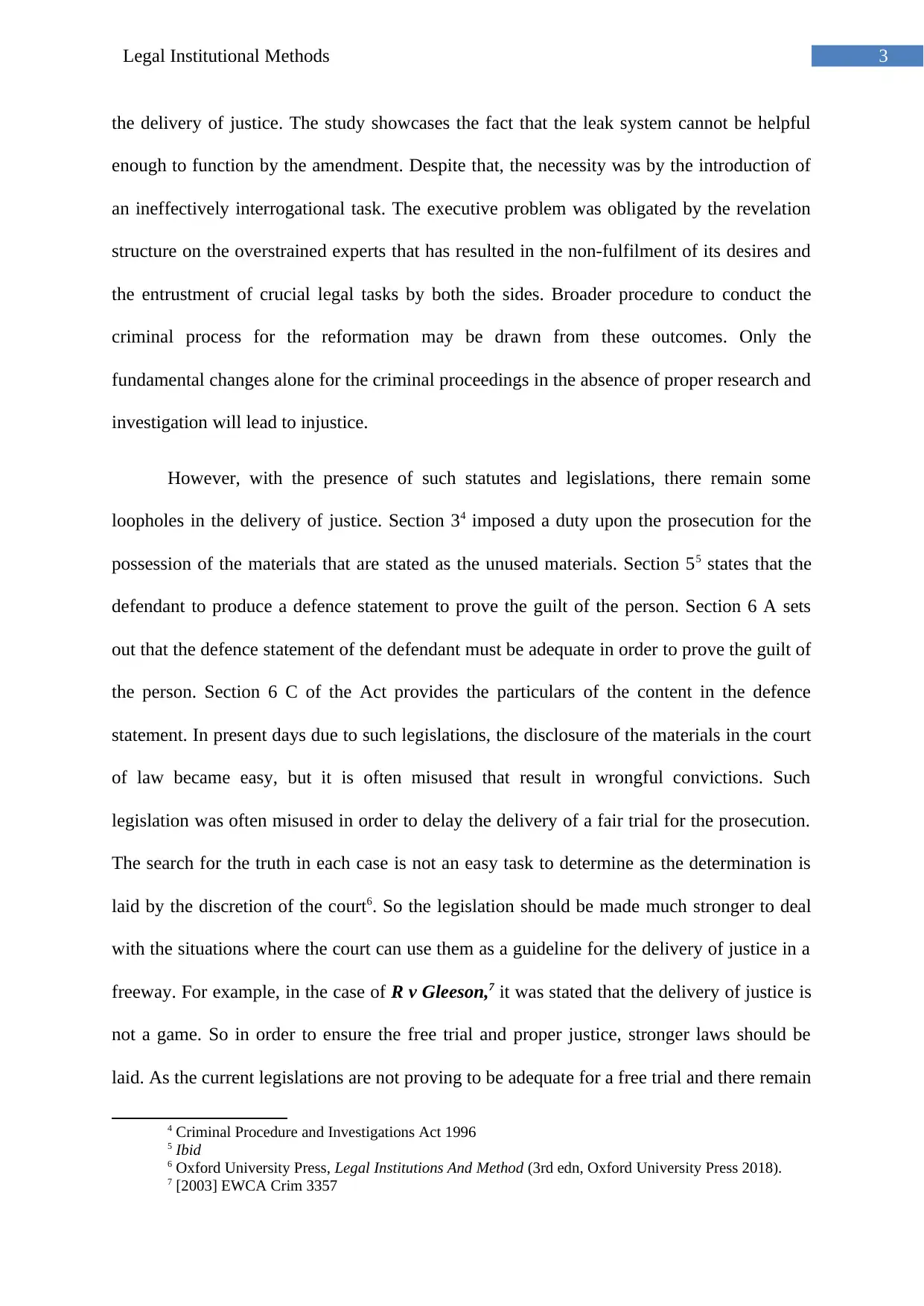
3Legal Institutional Methods
the delivery of justice. The study showcases the fact that the leak system cannot be helpful
enough to function by the amendment. Despite that, the necessity was by the introduction of
an ineffectively interrogational task. The executive problem was obligated by the revelation
structure on the overstrained experts that has resulted in the non-fulfilment of its desires and
the entrustment of crucial legal tasks by both the sides. Broader procedure to conduct the
criminal process for the reformation may be drawn from these outcomes. Only the
fundamental changes alone for the criminal proceedings in the absence of proper research and
investigation will lead to injustice.
However, with the presence of such statutes and legislations, there remain some
loopholes in the delivery of justice. Section 34 imposed a duty upon the prosecution for the
possession of the materials that are stated as the unused materials. Section 55 states that the
defendant to produce a defence statement to prove the guilt of the person. Section 6 A sets
out that the defence statement of the defendant must be adequate in order to prove the guilt of
the person. Section 6 C of the Act provides the particulars of the content in the defence
statement. In present days due to such legislations, the disclosure of the materials in the court
of law became easy, but it is often misused that result in wrongful convictions. Such
legislation was often misused in order to delay the delivery of a fair trial for the prosecution.
The search for the truth in each case is not an easy task to determine as the determination is
laid by the discretion of the court6. So the legislation should be made much stronger to deal
with the situations where the court can use them as a guideline for the delivery of justice in a
freeway. For example, in the case of R v Gleeson,7 it was stated that the delivery of justice is
not a game. So in order to ensure the free trial and proper justice, stronger laws should be
laid. As the current legislations are not proving to be adequate for a free trial and there remain
4 Criminal Procedure and Investigations Act 1996
5 Ibid
6 Oxford University Press, Legal Institutions And Method (3rd edn, Oxford University Press 2018).
7 [2003] EWCA Crim 3357
the delivery of justice. The study showcases the fact that the leak system cannot be helpful
enough to function by the amendment. Despite that, the necessity was by the introduction of
an ineffectively interrogational task. The executive problem was obligated by the revelation
structure on the overstrained experts that has resulted in the non-fulfilment of its desires and
the entrustment of crucial legal tasks by both the sides. Broader procedure to conduct the
criminal process for the reformation may be drawn from these outcomes. Only the
fundamental changes alone for the criminal proceedings in the absence of proper research and
investigation will lead to injustice.
However, with the presence of such statutes and legislations, there remain some
loopholes in the delivery of justice. Section 34 imposed a duty upon the prosecution for the
possession of the materials that are stated as the unused materials. Section 55 states that the
defendant to produce a defence statement to prove the guilt of the person. Section 6 A sets
out that the defence statement of the defendant must be adequate in order to prove the guilt of
the person. Section 6 C of the Act provides the particulars of the content in the defence
statement. In present days due to such legislations, the disclosure of the materials in the court
of law became easy, but it is often misused that result in wrongful convictions. Such
legislation was often misused in order to delay the delivery of a fair trial for the prosecution.
The search for the truth in each case is not an easy task to determine as the determination is
laid by the discretion of the court6. So the legislation should be made much stronger to deal
with the situations where the court can use them as a guideline for the delivery of justice in a
freeway. For example, in the case of R v Gleeson,7 it was stated that the delivery of justice is
not a game. So in order to ensure the free trial and proper justice, stronger laws should be
laid. As the current legislations are not proving to be adequate for a free trial and there remain
4 Criminal Procedure and Investigations Act 1996
5 Ibid
6 Oxford University Press, Legal Institutions And Method (3rd edn, Oxford University Press 2018).
7 [2003] EWCA Crim 3357
Paraphrase This Document
Need a fresh take? Get an instant paraphrase of this document with our AI Paraphraser
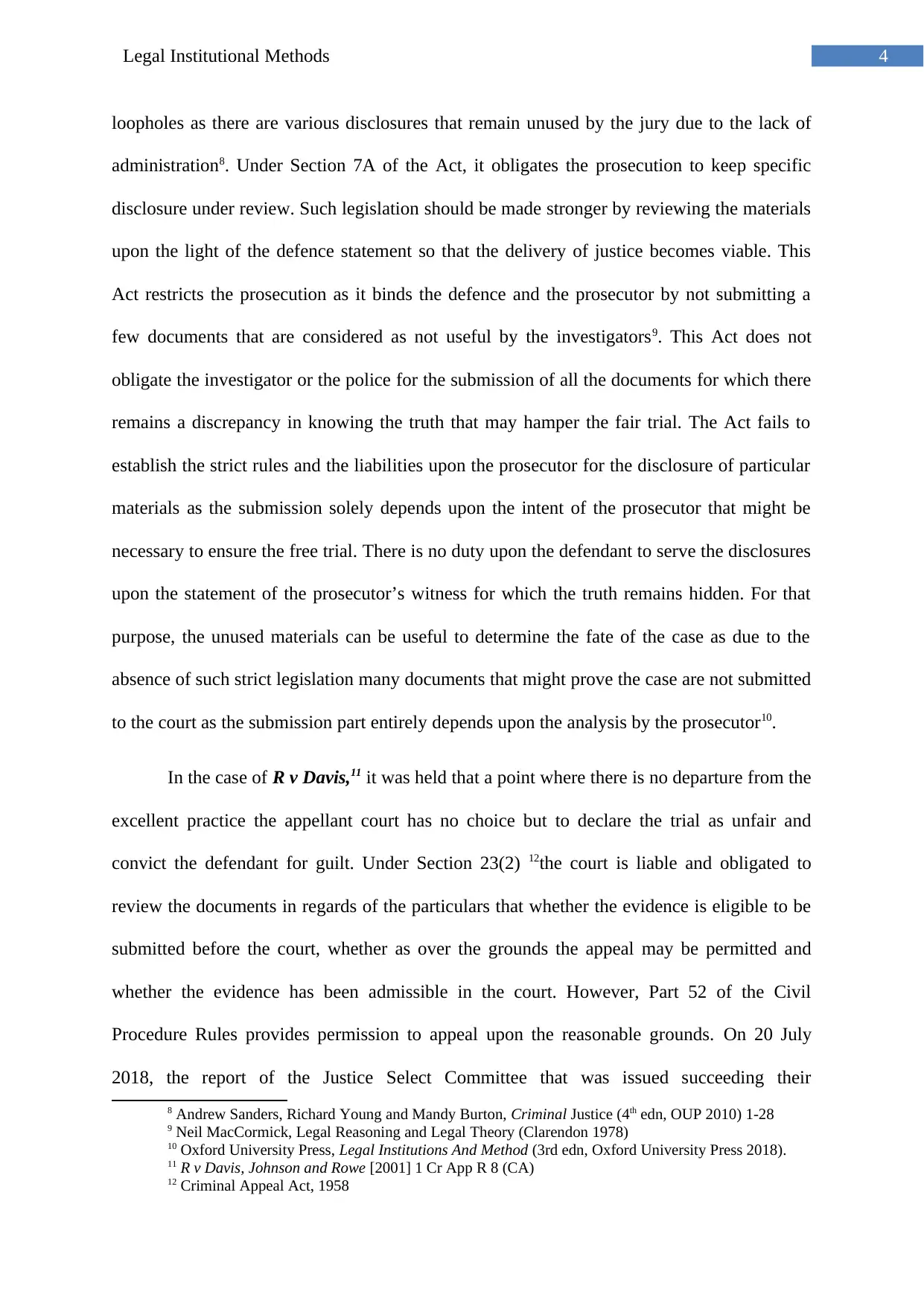
4Legal Institutional Methods
loopholes as there are various disclosures that remain unused by the jury due to the lack of
administration8. Under Section 7A of the Act, it obligates the prosecution to keep specific
disclosure under review. Such legislation should be made stronger by reviewing the materials
upon the light of the defence statement so that the delivery of justice becomes viable. This
Act restricts the prosecution as it binds the defence and the prosecutor by not submitting a
few documents that are considered as not useful by the investigators9. This Act does not
obligate the investigator or the police for the submission of all the documents for which there
remains a discrepancy in knowing the truth that may hamper the fair trial. The Act fails to
establish the strict rules and the liabilities upon the prosecutor for the disclosure of particular
materials as the submission solely depends upon the intent of the prosecutor that might be
necessary to ensure the free trial. There is no duty upon the defendant to serve the disclosures
upon the statement of the prosecutor’s witness for which the truth remains hidden. For that
purpose, the unused materials can be useful to determine the fate of the case as due to the
absence of such strict legislation many documents that might prove the case are not submitted
to the court as the submission part entirely depends upon the analysis by the prosecutor10.
In the case of R v Davis,11 it was held that a point where there is no departure from the
excellent practice the appellant court has no choice but to declare the trial as unfair and
convict the defendant for guilt. Under Section 23(2) 12the court is liable and obligated to
review the documents in regards of the particulars that whether the evidence is eligible to be
submitted before the court, whether as over the grounds the appeal may be permitted and
whether the evidence has been admissible in the court. However, Part 52 of the Civil
Procedure Rules provides permission to appeal upon the reasonable grounds. “On 20 July
2018, the report of the Justice Select Committee that was issued succeeding their
8 Andrew Sanders, Richard Young and Mandy Burton, Criminal Justice (4th edn, OUP 2010) 1-28
9 Neil MacCormick, Legal Reasoning and Legal Theory (Clarendon 1978)
10 Oxford University Press, Legal Institutions And Method (3rd edn, Oxford University Press 2018).
11 R v Davis, Johnson and Rowe [2001] 1 Cr App R 8 (CA)
12 Criminal Appeal Act, 1958
loopholes as there are various disclosures that remain unused by the jury due to the lack of
administration8. Under Section 7A of the Act, it obligates the prosecution to keep specific
disclosure under review. Such legislation should be made stronger by reviewing the materials
upon the light of the defence statement so that the delivery of justice becomes viable. This
Act restricts the prosecution as it binds the defence and the prosecutor by not submitting a
few documents that are considered as not useful by the investigators9. This Act does not
obligate the investigator or the police for the submission of all the documents for which there
remains a discrepancy in knowing the truth that may hamper the fair trial. The Act fails to
establish the strict rules and the liabilities upon the prosecutor for the disclosure of particular
materials as the submission solely depends upon the intent of the prosecutor that might be
necessary to ensure the free trial. There is no duty upon the defendant to serve the disclosures
upon the statement of the prosecutor’s witness for which the truth remains hidden. For that
purpose, the unused materials can be useful to determine the fate of the case as due to the
absence of such strict legislation many documents that might prove the case are not submitted
to the court as the submission part entirely depends upon the analysis by the prosecutor10.
In the case of R v Davis,11 it was held that a point where there is no departure from the
excellent practice the appellant court has no choice but to declare the trial as unfair and
convict the defendant for guilt. Under Section 23(2) 12the court is liable and obligated to
review the documents in regards of the particulars that whether the evidence is eligible to be
submitted before the court, whether as over the grounds the appeal may be permitted and
whether the evidence has been admissible in the court. However, Part 52 of the Civil
Procedure Rules provides permission to appeal upon the reasonable grounds. “On 20 July
2018, the report of the Justice Select Committee that was issued succeeding their
8 Andrew Sanders, Richard Young and Mandy Burton, Criminal Justice (4th edn, OUP 2010) 1-28
9 Neil MacCormick, Legal Reasoning and Legal Theory (Clarendon 1978)
10 Oxford University Press, Legal Institutions And Method (3rd edn, Oxford University Press 2018).
11 R v Davis, Johnson and Rowe [2001] 1 Cr App R 8 (CA)
12 Criminal Appeal Act, 1958
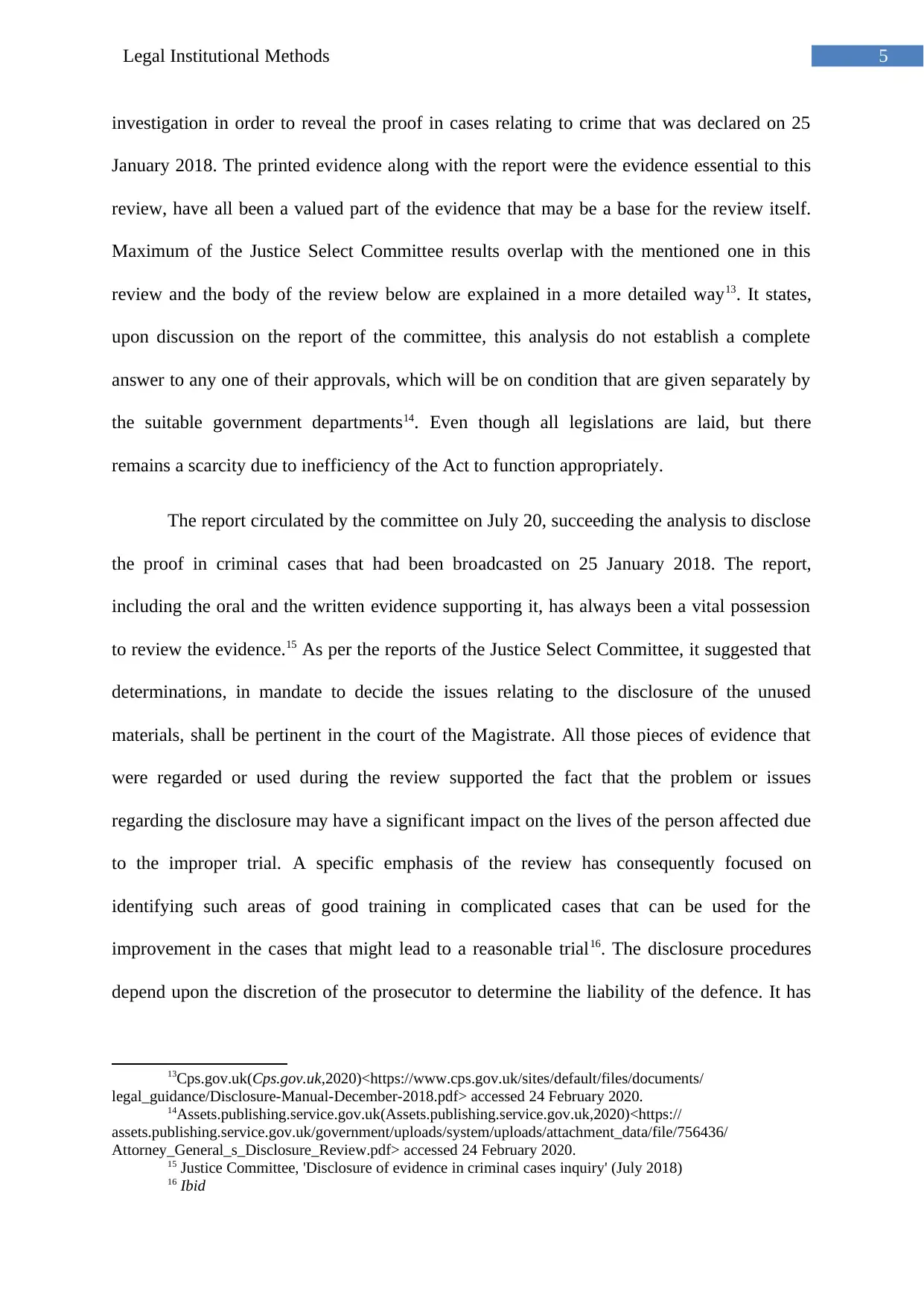
5Legal Institutional Methods
investigation in order to reveal the proof in cases relating to crime that was declared on 25
January 2018. The printed evidence along with the report were the evidence essential to this
review, have all been a valued part of the evidence that may be a base for the review itself.
Maximum of the Justice Select Committee results overlap with the mentioned one in this
review and the body of the review below are explained in a more detailed way13. It states,
upon discussion on the report of the committee, this analysis do not establish a complete
answer to any one of their approvals, which will be on condition that are given separately by
the suitable government departments14.” Even though all legislations are laid, but there
remains a scarcity due to inefficiency of the Act to function appropriately.
The report circulated by the committee on July 20, succeeding the analysis to disclose
the proof in criminal cases that had been broadcasted on 25 January 2018. The report,
including the oral and the written evidence supporting it, has always been a vital possession
to review the evidence.15 As per the reports of the Justice Select Committee, it suggested that
determinations, in mandate to decide the issues relating to the disclosure of the unused
materials, shall be pertinent in the court of the Magistrate. All those pieces of evidence that
were regarded or used during the review supported the fact that the problem or issues
regarding the disclosure may have a significant impact on the lives of the person affected due
to the improper trial. “A specific emphasis of the review has consequently focused on
identifying such areas of good training in complicated cases that can be used for the
improvement in the cases that might lead to a reasonable trial16. The disclosure procedures
depend upon the discretion of the prosecutor to determine the liability of the defence. It has
13Cps.gov.uk(Cps.gov.uk,2020)<https://www.cps.gov.uk/sites/default/files/documents/
legal_guidance/Disclosure-Manual-December-2018.pdf> accessed 24 February 2020.
14Assets.publishing.service.gov.uk(Assets.publishing.service.gov.uk,2020)<https://
assets.publishing.service.gov.uk/government/uploads/system/uploads/attachment_data/file/756436/
Attorney_General_s_Disclosure_Review.pdf> accessed 24 February 2020.
15 Justice Committee, 'Disclosure of evidence in criminal cases inquiry' (July 2018)
16 Ibid
investigation in order to reveal the proof in cases relating to crime that was declared on 25
January 2018. The printed evidence along with the report were the evidence essential to this
review, have all been a valued part of the evidence that may be a base for the review itself.
Maximum of the Justice Select Committee results overlap with the mentioned one in this
review and the body of the review below are explained in a more detailed way13. It states,
upon discussion on the report of the committee, this analysis do not establish a complete
answer to any one of their approvals, which will be on condition that are given separately by
the suitable government departments14.” Even though all legislations are laid, but there
remains a scarcity due to inefficiency of the Act to function appropriately.
The report circulated by the committee on July 20, succeeding the analysis to disclose
the proof in criminal cases that had been broadcasted on 25 January 2018. The report,
including the oral and the written evidence supporting it, has always been a vital possession
to review the evidence.15 As per the reports of the Justice Select Committee, it suggested that
determinations, in mandate to decide the issues relating to the disclosure of the unused
materials, shall be pertinent in the court of the Magistrate. All those pieces of evidence that
were regarded or used during the review supported the fact that the problem or issues
regarding the disclosure may have a significant impact on the lives of the person affected due
to the improper trial. “A specific emphasis of the review has consequently focused on
identifying such areas of good training in complicated cases that can be used for the
improvement in the cases that might lead to a reasonable trial16. The disclosure procedures
depend upon the discretion of the prosecutor to determine the liability of the defence. It has
13Cps.gov.uk(Cps.gov.uk,2020)<https://www.cps.gov.uk/sites/default/files/documents/
legal_guidance/Disclosure-Manual-December-2018.pdf> accessed 24 February 2020.
14Assets.publishing.service.gov.uk(Assets.publishing.service.gov.uk,2020)<https://
assets.publishing.service.gov.uk/government/uploads/system/uploads/attachment_data/file/756436/
Attorney_General_s_Disclosure_Review.pdf> accessed 24 February 2020.
15 Justice Committee, 'Disclosure of evidence in criminal cases inquiry' (July 2018)
16 Ibid
⊘ This is a preview!⊘
Do you want full access?
Subscribe today to unlock all pages.

Trusted by 1+ million students worldwide
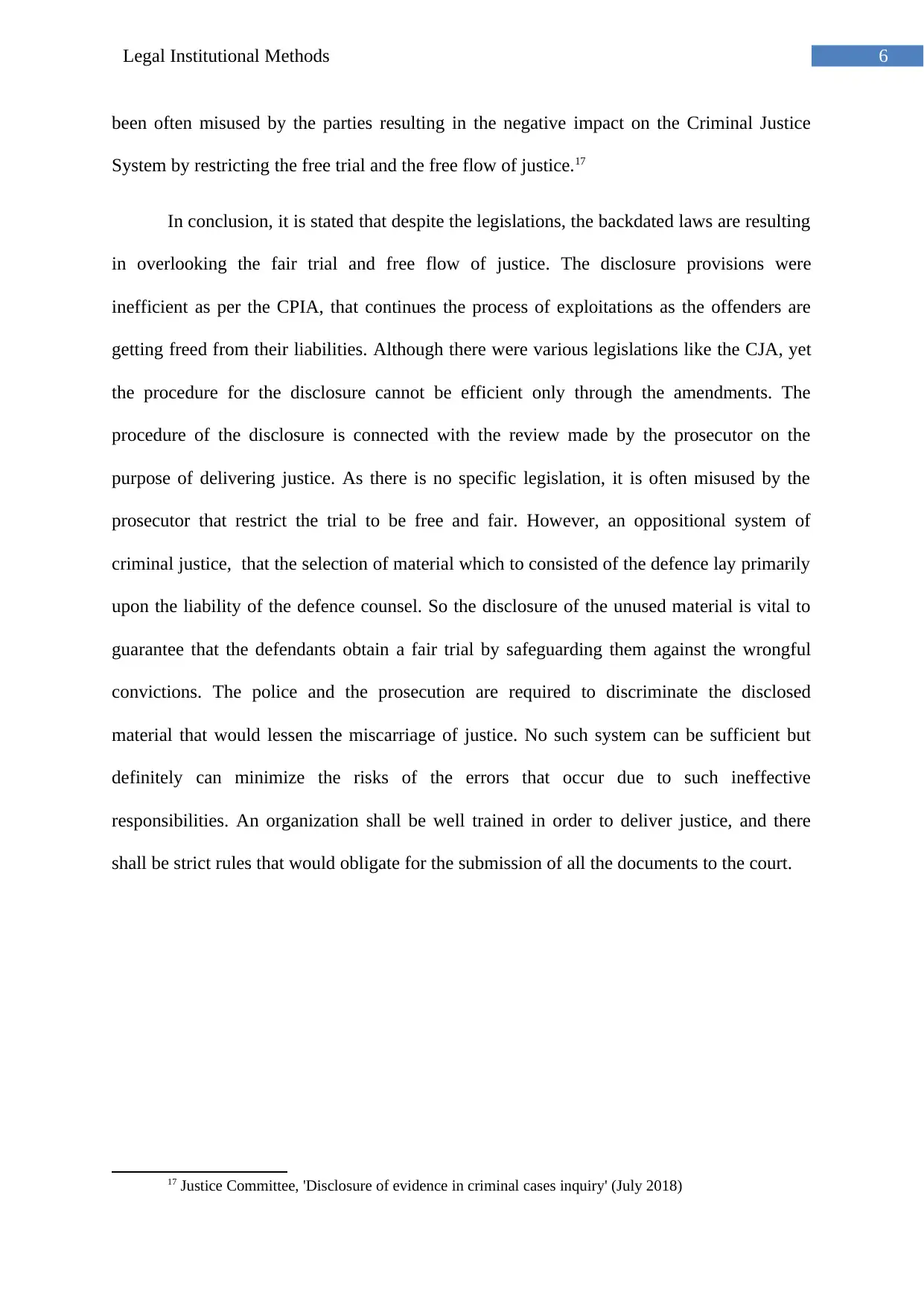
6Legal Institutional Methods
been often misused by the parties resulting in the negative impact on the Criminal Justice
System by restricting the free trial and the free flow of justice.17
In conclusion, it is stated that despite the legislations, the backdated laws are resulting
in overlooking the fair trial and free flow of justice. The disclosure provisions were
inefficient as per the CPIA, that continues the process of exploitations as the offenders are
getting freed from their liabilities. Although there were various legislations like the CJA, yet
the procedure for the disclosure cannot be efficient only through the amendments. The
procedure of the disclosure is connected with the review made by the prosecutor on the
purpose of delivering justice. As there is no specific legislation, it is often misused by the
prosecutor that restrict the trial to be free and fair. However, an oppositional system of
criminal justice, that the selection of material which to consisted of the defence lay primarily
upon the liability of the defence counsel. So the disclosure of the unused material is vital to
guarantee that the defendants obtain a fair trial by safeguarding them against the wrongful
convictions. The police and the prosecution are required to discriminate the disclosed
material that would lessen the miscarriage of justice. No such system can be sufficient but
definitely can minimize the risks of the errors that occur due to such ineffective
responsibilities. An organization shall be well trained in order to deliver justice, and there
shall be strict rules that would obligate for the submission of all the documents to the court.
17 Justice Committee, 'Disclosure of evidence in criminal cases inquiry' (July 2018)
been often misused by the parties resulting in the negative impact on the Criminal Justice
System by restricting the free trial and the free flow of justice.17
In conclusion, it is stated that despite the legislations, the backdated laws are resulting
in overlooking the fair trial and free flow of justice. The disclosure provisions were
inefficient as per the CPIA, that continues the process of exploitations as the offenders are
getting freed from their liabilities. Although there were various legislations like the CJA, yet
the procedure for the disclosure cannot be efficient only through the amendments. The
procedure of the disclosure is connected with the review made by the prosecutor on the
purpose of delivering justice. As there is no specific legislation, it is often misused by the
prosecutor that restrict the trial to be free and fair. However, an oppositional system of
criminal justice, that the selection of material which to consisted of the defence lay primarily
upon the liability of the defence counsel. So the disclosure of the unused material is vital to
guarantee that the defendants obtain a fair trial by safeguarding them against the wrongful
convictions. The police and the prosecution are required to discriminate the disclosed
material that would lessen the miscarriage of justice. No such system can be sufficient but
definitely can minimize the risks of the errors that occur due to such ineffective
responsibilities. An organization shall be well trained in order to deliver justice, and there
shall be strict rules that would obligate for the submission of all the documents to the court.
17 Justice Committee, 'Disclosure of evidence in criminal cases inquiry' (July 2018)
Paraphrase This Document
Need a fresh take? Get an instant paraphrase of this document with our AI Paraphraser
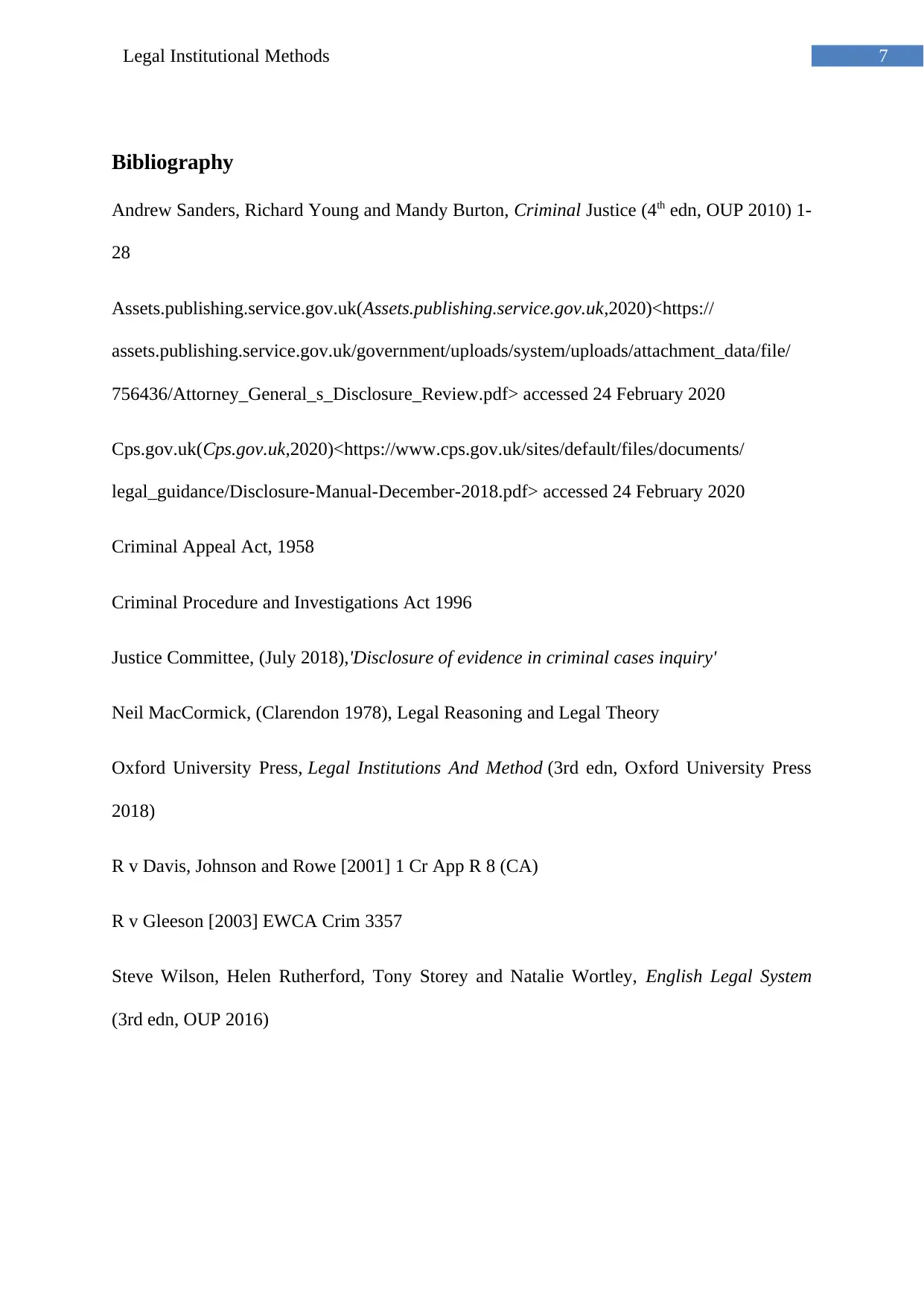
7Legal Institutional Methods
Bibliography
Andrew Sanders, Richard Young and Mandy Burton, Criminal Justice (4th edn, OUP 2010) 1-
28
Assets.publishing.service.gov.uk(Assets.publishing.service.gov.uk,2020)<https://
assets.publishing.service.gov.uk/government/uploads/system/uploads/attachment_data/file/
756436/Attorney_General_s_Disclosure_Review.pdf> accessed 24 February 2020
Cps.gov.uk(Cps.gov.uk,2020)<https://www.cps.gov.uk/sites/default/files/documents/
legal_guidance/Disclosure-Manual-December-2018.pdf> accessed 24 February 2020
Criminal Appeal Act, 1958
Criminal Procedure and Investigations Act 1996
Justice Committee, (July 2018),'Disclosure of evidence in criminal cases inquiry'
Neil MacCormick, (Clarendon 1978), Legal Reasoning and Legal Theory
Oxford University Press, Legal Institutions And Method (3rd edn, Oxford University Press
2018)
R v Davis, Johnson and Rowe [2001] 1 Cr App R 8 (CA)
R v Gleeson [2003] EWCA Crim 3357
Steve Wilson, Helen Rutherford, Tony Storey and Natalie Wortley, English Legal System
(3rd edn, OUP 2016)
Bibliography
Andrew Sanders, Richard Young and Mandy Burton, Criminal Justice (4th edn, OUP 2010) 1-
28
Assets.publishing.service.gov.uk(Assets.publishing.service.gov.uk,2020)<https://
assets.publishing.service.gov.uk/government/uploads/system/uploads/attachment_data/file/
756436/Attorney_General_s_Disclosure_Review.pdf> accessed 24 February 2020
Cps.gov.uk(Cps.gov.uk,2020)<https://www.cps.gov.uk/sites/default/files/documents/
legal_guidance/Disclosure-Manual-December-2018.pdf> accessed 24 February 2020
Criminal Appeal Act, 1958
Criminal Procedure and Investigations Act 1996
Justice Committee, (July 2018),'Disclosure of evidence in criminal cases inquiry'
Neil MacCormick, (Clarendon 1978), Legal Reasoning and Legal Theory
Oxford University Press, Legal Institutions And Method (3rd edn, Oxford University Press
2018)
R v Davis, Johnson and Rowe [2001] 1 Cr App R 8 (CA)
R v Gleeson [2003] EWCA Crim 3357
Steve Wilson, Helen Rutherford, Tony Storey and Natalie Wortley, English Legal System
(3rd edn, OUP 2016)

8Legal Institutional Methods
⊘ This is a preview!⊘
Do you want full access?
Subscribe today to unlock all pages.

Trusted by 1+ million students worldwide
1 out of 9
Related Documents
Your All-in-One AI-Powered Toolkit for Academic Success.
+13062052269
info@desklib.com
Available 24*7 on WhatsApp / Email
![[object Object]](/_next/static/media/star-bottom.7253800d.svg)
Unlock your academic potential
Copyright © 2020–2025 A2Z Services. All Rights Reserved. Developed and managed by ZUCOL.





